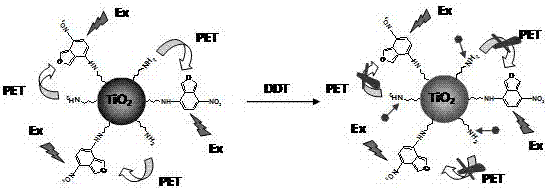Preparation method for titanium dioxide nano particle fluorescence probe for detection DDT
A nanoparticle and titanium dioxide technology, which is applied in the field of material science, can solve the problems of DDT trace detection, etc., and achieve the effect of improving selective recognition, enhancing fluorescence intensity, and improving high-sensitivity detection
- Summary
- Abstract
- Description
- Claims
- Application Information
AI Technical Summary
Problems solved by technology
Method used
Image
Examples
preparation example Construction
[0050] A method for preparing a titanium dioxide nanoparticle fluorescent probe for DDT detection, characterized in that: the aminopropyl group on the imprinted recognition site inside the titanium dioxide nanoparticle fluorescent probe can interact with the DDT molecule entering the recognition site Function, the hydrogen atom on the aminopropyl group forms a hydrogen bond with the chlorine atom on the DDT molecule to stabilize the aminopropyl group. When light is excited, it prevents the electron transfer of the nitrogen atom on the aminopropyl group to the NBD-APTS complex. According to the light-induced The mechanism of electron transfer leads to the enhancement of the fluorescence intensity of the complex. Through the matching of imprinted sites and the change of fluorescence intensity, the recognition and detection of DDT molecules are realized. The preparation process includes the following three steps:
[0051] 1.1 Preparation of NBD-APTS complex: First, accurately weig...
Embodiment
[0056] Example: Firstly, the NBD-APTS complex is prepared according to the covalent coupling reaction, and then the fluorescent probe of titanium dioxide nanoparticles whose surface is rich in amino groups can be obtained according to the non-covalent bond (hydrogen bond) reaction and cross-linking reaction.
[0057]The first step is the preparation of the NBD-APTS complex: First, accurately weigh 0.0016g of 4-chloro-7-nitrobenzofurazan (NBD-Cl) with an electronic balance and place it in a 50mL single Then, use a microsampler with a volume range of 100 μL ~ 1000 μL to draw 220 μL of 3-aminopropyltriethoxysilane (3-aminopropyltriethoxysilane, APTS) into the above flask, and finally, add Add 16 mL of ethanol to the flask, ultrasonically disperse the mixture in the flask for 5 min, and react at 50°C for 2 h at a stirring speed of 500 rpm in an inert atmosphere;
[0058] The second step is the preparation of the EDA-ICPTS complex: First, accurately weigh 0.4240g 4,4'-ethylenebisph...
PUM
 Login to View More
Login to View More Abstract
Description
Claims
Application Information
 Login to View More
Login to View More - R&D
- Intellectual Property
- Life Sciences
- Materials
- Tech Scout
- Unparalleled Data Quality
- Higher Quality Content
- 60% Fewer Hallucinations
Browse by: Latest US Patents, China's latest patents, Technical Efficacy Thesaurus, Application Domain, Technology Topic, Popular Technical Reports.
© 2025 PatSnap. All rights reserved.Legal|Privacy policy|Modern Slavery Act Transparency Statement|Sitemap|About US| Contact US: help@patsnap.com



